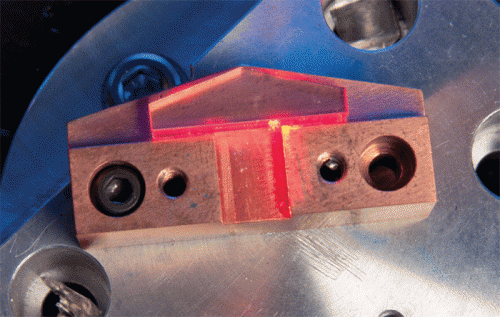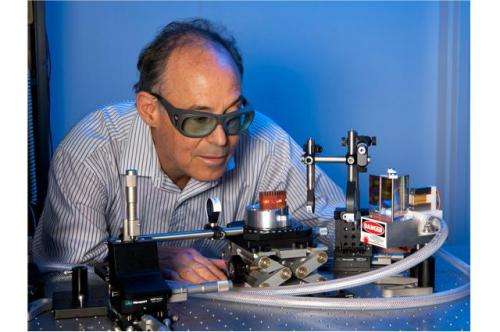Thin disk laser power amplifier with greatly enhanced cooling properties

Researchers at the US Army Research Laboratory (ARL) have developed a thin disk laser power amplifier with greatly enhanced cooling properties. The amplifier allows power scaling to be extended up to two and a half times, whilst maintaining a very high quality beam.
Hot work
The master oscillator power amplifier (MOPA) configuration is the most common method used to scale the power of a seed laser (MO) to meet the power requirements of specific applications. However, the extent to which the power can be scaled is inherently limited by the heat generated and the laser system's ability to deal with it.
One way to limit the heat generated in the amplifier is to operate it in quasi-continuous wave (Q-CW) mode at a duty cycle less than 100%. By pulsing the PA pump power, the overall thermal load on the pumps and the laser gain element is reduced, while still allowing for the same momentary power of CW operation without output beam quality degradation.
Q-CW high power laser sources are often used wherever pulsed power with high instantaneous power during the pump duration, or Q-switched pulses with very high per pulse energy, are needed. The reduced thermal load of Q-CW operation compared to CW reduces the cooling required in the laser system overall, allowing very compact, light and power efficient laser source packages.
These kinds of source are used in a range of applications within machining, medicine and nonlinear optics, as well as military applications, including rangefinders and designators, but their power scaling is still limited by cooling requirements.

"Any laser system has its power limit and further power scaling requires additional sophistication in thermal management of the gain element. Legacy design thin disk lasers (TDLs) offer advanced thermal management compared to rod-based or slab-based lasers, due to their much larger surface area to gain volume ratio, but their thermal management is still limited by single-sided cooling," US ARL researcher Dr George Newburgh explained.
Cooling sandwich
In the work reported in this issue of Electronics Letters, the US ARL authors address the cooling issue using an optically transparent heat sink to allow the gain medium to be cooled from two sides, extending the possible power scaling range by a factor of around 2.5.
As well as the normal copper heat sink attached to the non-lasing side of the gain element, their design uses a transparent, single-crystalline silicon carbide component to act as a heat sink on the lasing/pumping side. This component is as thermally conductive as copper, providing excellent heat transport without interfering optically with the laser's operation.
The compact amplifier has also been designed to minimise mechanical stress between the SiC heat sink and the gain medium through the choice of Yttrium orthovanadate (YVO 4) as the laser host medium. The thermal expansion coefficients of SiC and Nd:YVO 4 are nearly the same, allowing the amplifier to operate at high temperatures without the SiC and YVO 4 layers delaminating.
The paper authors, Dr George Newburgh and Dr Mark Dubinskii, explained that the current device is the result of a series of advances made within the ARL team: "It started with the question as to whether SiC could be used instead of the originally proven method of using diamond as an optically transparent heat sink. The first embodiment of this relied on bonding Nd:YAG gain medium to SiC, and cooling the stack assembly in a water-cooled chamber. While the laser worked, the bond was weak and suffered from high losses due to high Fresnel reflection at the interface. The subsequent design modified the 'simple stack' assembly into a less obvious 'bonded-prism' architecture which allowed them to take advantage of Brewster angle incidence at the air/SiC and SiC/gain interface – minimising optical losses at interfaces without the use of any coatings."
Lights ahead
The ARL team believe the concept of high power scalable lasers with nearly diffraction limited output, based on hetero-composite gain media designs, will become increasingly important over the next decade. They hope that this work, along with the latest developments in high quality laser ceramics, including composites, and recent advances in alternative high optical quality transparent materials, such as gallium nitride and magnesium oxide, will encourage more research and development utilising transparent materials with high thermal conductivity.
"We are hoping that our new hetero-composite amplifier gain element design will pave the way for a new generation of pulse-repetitive optical amplifiers where compactness and high output power with nearly diffraction limited beam quality are required," said Newburgh.
In the shorter term, the authors think the design could be used almost immediately in power amplifiers for nanosecond pulse amplification in a hybrid 'fibre-bulk solid-state' MOPA system in order to meet high pulsed energy requirements, where fibre amplifiers are severely limited by stimulated Brillouin scattering.
More information: "Compact, high gain, hetero-composite Nd:YVO4/SiC thin disk amplifier with advanced thermal management." G.A. Newburgh and M. Dubinskii. Electronics Letters, Volume 50, Issue 16, 31 July 2014, p. 1152 – 1153. DOI: 10.1049/el.2014.1900 , Print ISSN 0013-5194, Online ISSN 1350-911X
Journal information: Electronics Letters
Provided by Institution of Engineering and Technology
This story is published courtesy of Electronics Letters. For additional Electronics Letters news and features visit theiet.org/eletters.


















